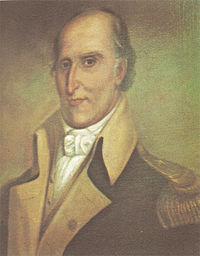Battle of Kettle Creek
| Battle of Kettle Creek | |||||||
|---|---|---|---|---|---|---|---|
| Part of the American Revolutionary War | |||||||
 Andrew Pickens, portrait by Thomas Sully |
|||||||
|
|||||||
| Belligerents | |||||||
|
|
|
||||||
| Commanders and leaders | |||||||
|
John Boyd † William Spurgen |
Andrew Pickens John Dooly Elijah Clarke |
||||||
| Strength | |||||||
| 600–700 militia | 340–420 militia | ||||||
| Casualties and losses | |||||||
| 40–70 killed 75 wounded or captured |
7-9 killed 14-23 wounded or missing |
||||||
The Battle of Kettle Creek (February 14, 1779) was a major encounter in the back country of Georgia during the American Revolutionary War. It was fought in Wilkes County about eight miles (13 km) from present-day Washington, Georgia. A militia force of Patriots decisively defeated and scattered a Loyalist militia force that was on its way to British-controlled Augusta.
The victory demonstrated the inability of British forces to hold the interior of the state, or to protect even sizable numbers of Loyalist recruits outside their immediate protection. The British, who had already decided to abandon Augusta, recovered some prestige a few weeks later, surprising a Patriot force in the Battle of Brier Creek. Georgia's back country would not come fully under British control until after the 1780 Siege of Charleston broke Patriot forces in the South.
The British began their "southern strategy" by sending expeditions from New York City and Saint Augustine, East Florida to capture the port of Savannah, Georgia in late 1778. The New York expedition, under the command of Lieutenant Colonel Archibald Campbell, arrived first, landing at Tybee Island on December 3, 1778, and successfully captured Savannah on December 29, 1778.
...
Wikipedia
